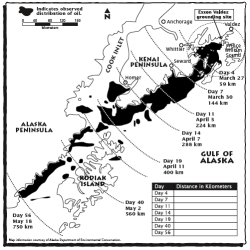Source Institutions
Source Institutions
Add to list Go to activity
Activity link broken? See if it's at the internet archive

In this activity (on pages 18-29) learners explore the impact of the March 24, 1989 oil spill in Alaska caused by the Exxon Valdez tanker. First they use a map to track the movement of the spill over 56 days. Learners then explore how oil behaves in water by examining the relative weight of water vs. oil, and the properties of oil. They test how oil damages various natural materials such as bird feathers, fur fabric, plants, shells, and rocks, and then try water and detergent to see which cleaning methods work best.
- 10 to 30 minutes
- 1 to 2 hours
- $5 - $10 per group of students
- Ages 8 - 14
- Activity, Experiment/Lab Activity
- English, Spanish
Quick Guide
Materials List (per group of students)
- Exxon Valdez Oil Spill Map (optional)
- 1 newspaper to cover work area
- Scale -- gram wts.
- 3 baby food jars
- 1 quart motor oil
- water
- plastic pipet or dropper
- 2 paper towels
- plastic spoons
- cup of motor oil
- feathers, fur fabric
- small rocks, sea shells
- parsley or carrot tops
- small brush
- cotton balls
- shallow pan
- hot water
- Liquid Dawn detergent
Subjects
-
Earth and Space Science
-
Earth Structure
- Oceans and Water
-
Earth Structure
-
Engineering and Technology
-
Engineering
- Ocean Engineering
-
Engineering
-
Life Sciences
-
Ecology
- Human Impact
-
Ecology
-
Physical Sciences
-
Chemistry
- Solutions
-
Chemistry
-
The Nature of Science
-
The Scientific Process
- Asking Questions
- Conducting Investigations
- Gathering Data
- Formulating Explanations
-
The Scientific Process
-
The Nature of Technology
-
Technology and Society
- Impacts of Technology
- Technology and the Environment
-
The Design Process
- Research and Development
-
Technology and Society
Informal Categories
- Animals
- Nature and Environment
Audience
To use this activity, learners need to:
- see
- touch
Learning styles supported:
- Involves teamwork and communication skills
- Uses STEM to solve real-world problems
- Involves hands-on or lab activities
Designed specifically for
- Rural dweller
Culture, ethnicity, and gender
-
Girls
- Explicity developed for this group
Other
Foreign language versions of this resource:
Components that are part of this resource:
Includes alignment to state and/or national standards:
This resource is part of:
Access Rights:
- Free access
By:
Source Collection
- Science After School Consumer's Guide
Funding Sources:
- National Science Foundation Informal Science Education Program
- Howard Hughes Medical Institute
